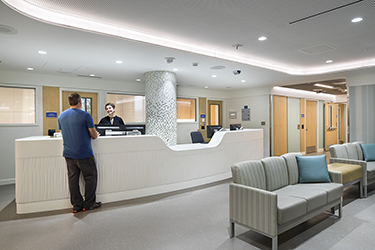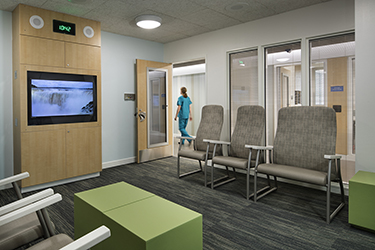|
Subscribe / Renew |
|
|
Contact Us |
|
| ► Subscribe to our Free Weekly Newsletter | |
| home | Welcome, sign in or click here to subscribe. | login |
Construction
| |
 |
February 27, 2020
How welcoming design can improve outcomes for patients — and staff
ZGF

Thorsen
|
In the past decade alone, the health care design community has made tremendous strides toward bringing design parity to behavioral health, an important step in destigmatizing mental illness.
From the moment patients and their families arrive in a behavioral health environment, the care and attention paid to its design should signal that they are welcome, and that the help they seek is no different than any other health care need. This represents a significant departure from the days when these facilities embodied the marginalization and stigma of mental illness. Many looked like jails — and some still do.
With today’s behavioral health units, in particular, designers and planners have a responsibility to advocate for bringing beauty, respite and healing to the spaces while still keeping patients from self-harm.
Progress starts with creating an interior environment that is familiar to those seeking care.
For instance, materials and finishes that connect to the natural world through texture and color. Fixtures that resemble what we might encounter in our everyday lives including door handles, coat hooks, toilets and faucets. Giving patients choices about their environment. Furnishing common areas with comfortable furniture that draws people out of their rooms to seek connections with providers and fellow patients. And providing daylight and views, as well as restorative garden landscapes outside.
Yet as we continue to reset patient and family expectations, it’s critical to prioritize the experience of staff as well.
Across the region, the health care industry is grappling with a workforce shortage. The problem is especially acute in the behavioral health setting, something that’s far from unique to our corner of the country.
In addition to the challenges of recruiting new staff, retaining existing workers and providing an environment that’s conducive to health has proven be elusive. Research has shown that more than half of mental health workers suffer from symptoms of burnout. In addition to the negative effects on their own health, employee burnout is also linked — not surprisingly — to in-unit care that results in worse outcomes for patients.
Support for staff
While a growing body of research has shown that the physical environment has great potential to impact patient outcomes, there is also evidence to suggest that investing in well-designed spaces can benefit the health and performance of care teams. A 2015 study in the Journal of Nursing Management, for instance, found that well-designed areas of respite can lead to greater job satisfaction, performance and retention, while having a positive impact on nurses’ health.
Opportunities include small respite rooms, daylit lounges and massage chairs.
Providing staff with a variety of work settings — onstage and off — can also support the many dimensions of their jobs. Offstage, quiet nooks for heads-down work can be supplemented with open-plan work zones with partitions, offering added opportunities for communication and consultation with fellow team members.
Within the behavioral health unit itself, incorporating casual touchdown spaces throughout can promote interactions and relationship-building with patients. Also within the behavioral health unit, elements like open nursing stations can also change the staff-patient dynamic for the better while enhancing transparency. Research has shown that open stations are also preferred by nurses.
During the design of the recently completed 22-bed behavioral health unit at Swedish Medical Center in Ballard, we implemented a custom-milled reception desk at the main staff workspace area. Built from Corian, its unique shape and textural edges emulate an art feature.
The desk also doubles as a potential barrier between patients and staff, when needed. This presents a welcome departure from the more familiar depictions in movies, where nurses are seated behind a wire-glass enclosure. We sought to strike a balance between size and durability needs with a desire to project a warm, welcoming, and comforting environment.
Incorporating nature
More than three decades have passed since a landmark study from health care design researcher Roger Ulrich affirmed the idea that views to nature can support hospital patients in their journeys to healing. It’s become clear that light-infused, nature-inspired spaces can help patients feel at ease, no matter how serious or momentous the reason for their visit, and no matter the length of their stays.
To shape the patient and provider experience, we take an interdisciplinary approach, recognizing that people experience buildings well before they cross the threshold. We often partner with our urban design team to ensure that our buildings are designed from the outside in, so that visual cues from the outdoors are legible from inside and keep us connected to the natural world.
Landscaped healing gardens in particular have been shown to confer benefits to hospital staff by reducing stress and improving emotional health.
For behavioral health patients, they not only have the potential to extend the therapeutic benefits of treatment, but to provide a verdant backdrop for walking paths and exercise space. Movement is foundational to wellness, and routines established within the in-unit environment can be maintained long after patients are discharged. And while these gardens aren’t common in our state’s behavioral health facilities, there’s no reason why such a space can’t be designed to be safe and secure, and to include distinct zones for care providers to enjoy.
Reducing stress
Many of the ideas outlined so far carry dual benefits. Research has linked more therapeutic environments with reduced aggression in patients. That means lessening the need for medication and restraints and in turn, lowering the overall stress of the providers who look after them.
In some cases, incorporating these ideas isn’t feasible because of the challenges inherent to a particular project. Despite these obstacles, it’s possible to design an environment that breaks convention and raises the bar for care.
Inside the recently completed behavioral health unit at Swedish Medical Center in Ballard, we incorporated a color-tunable LED lighting system in the unit’s common areas. The unit was built within two floors of the existing hospital, which receive little daylight. The aim was to imbue the space with changing light to mimic the color and intensity of daylight throughout the day, thereby synchronizing patients’ natural sleep-wake rhythms, marking the passage of time, instilling routine, and providing a sense of calm as the day winds down. Not only does this support healthy circadian rhythms for patients, but it benefits staff who spend considerable time each week within the same spaces.
To enhance the unit’s physical environment, existing structural columns were transformed with glass and ceramic tile that feature colors and textures evoking the natural environment of the Pacific Northwest. This attention to detail and aesthetic beauty contrasts with the design of older behavioral units, where durability considerations were prioritized and where columns were often wrapped in concrete and painted, leaving grooves, steel housings, and fixtures exposed.
A year after it opened, we surveyed 18 providers working within the unit as part of a post-occupancy evaluation. They reported that the circadian lighting had a calming effect on patients, and that patients perceived the colors and textures in the communal spaces as soothing.
When design elements in the behavioral health setting start to look like the kind we’d encounter in other health care environments, or even in our homes, the more likely it is that people who need help will feel comfortable seeking it. And the more likely that their care providers will feel supported and empowered while on the job.
With one of the nation’s highest incidences of mental illness and a pronounced workforce shortage, the need in Washington state has never been more urgent. We have a responsibility — and an opportunity — to help design the path forward.
ZGF principal Kari Thorsen leads the planning and interior design of many of ZGF’s largest health care projects locally and nationwide.
Other Stories:
- Hospital projects in rural areas face extra obstacles
- UW’s new health sciences building will be a hub for 21st-century care
- Good design takes some stress out of visiting the hospital
- Building out this new hybrid OR was no simple operation
- Fire dampers: one more way hospitals can save lives
- Hospitals giving way to other care options as providers look to cut costs
- CHP systems: a powerful energy-saving tool for hospitals
- A look inside the Cure Factory, Seattle Children’s new cell therapy lab
- Health care could look a lot different in 2040, so get ready
- Here’s what’s in store for health care in the Northwest
- Integrated project delivery offers risks and rewards for team members




